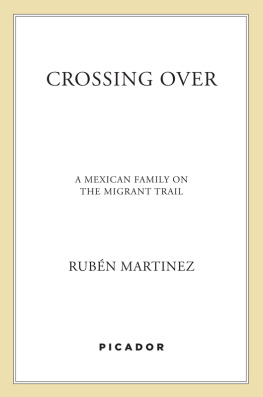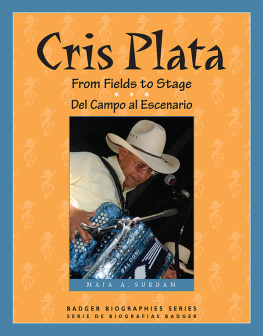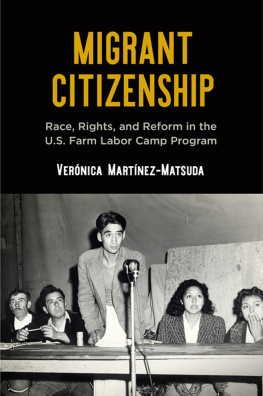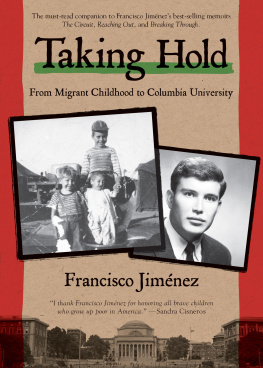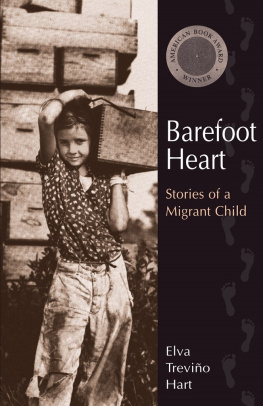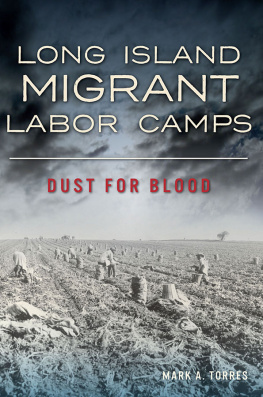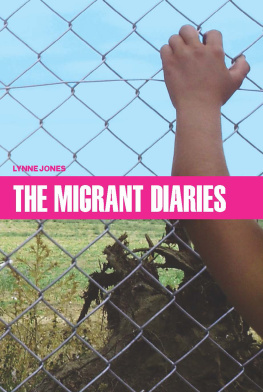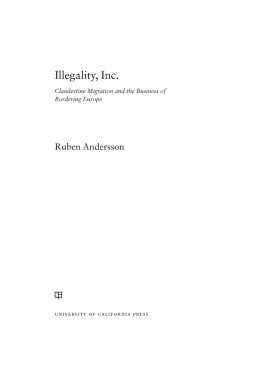Ruben Martinez - Crossing Over: A Mexican Family on the Migrant Trail
Here you can read online Ruben Martinez - Crossing Over: A Mexican Family on the Migrant Trail full text of the book (entire story) in english for free. Download pdf and epub, get meaning, cover and reviews about this ebook. year: 2002, publisher: Turtleback, genre: Detective and thriller. Description of the work, (preface) as well as reviews are available. Best literature library LitArk.com created for fans of good reading and offers a wide selection of genres:
Romance novel
Science fiction
Adventure
Detective
Science
History
Home and family
Prose
Art
Politics
Computer
Non-fiction
Religion
Business
Children
Humor
Choose a favorite category and find really read worthwhile books. Enjoy immersion in the world of imagination, feel the emotions of the characters or learn something new for yourself, make an fascinating discovery.
- Book:Crossing Over: A Mexican Family on the Migrant Trail
- Author:
- Publisher:Turtleback
- Genre:
- Year:2002
- Rating:5 / 5
- Favourites:Add to favourites
- Your mark:
- 100
- 1
- 2
- 3
- 4
- 5
Crossing Over: A Mexican Family on the Migrant Trail: summary, description and annotation
We offer to read an annotation, description, summary or preface (depends on what the author of the book "Crossing Over: A Mexican Family on the Migrant Trail" wrote himself). If you haven't found the necessary information about the book — write in the comments, we will try to find it.
Crossing Over: A Mexican Family on the Migrant Trail — read online for free the complete book (whole text) full work
Below is the text of the book, divided by pages. System saving the place of the last page read, allows you to conveniently read the book "Crossing Over: A Mexican Family on the Migrant Trail" online for free, without having to search again every time where you left off. Put a bookmark, and you can go to the page where you finished reading at any time.
Font size:
Interval:
Bookmark:

The author and publisher have provided this e-book to you for your personal use only. You may not make this e-book publicly available in any way. Copyright infringement is against the law. If you believe the copy of this e-book you are reading infringes on the authors copyright, please notify the publisher at: us.macmillanusa.com/piracy.
Contents
For Benjamn, Jaime, and Salvador Chvez, in memoriam
For Mara Elena Chvez, her daughter, Rosa, and her granddaughters, Anayeli and Emily-Elizabeth: the future is yours
For my parents, whose journeys inspired mine
And for Joseph Rodriguez, whose eyes helped mine to see
Black markets flourish everywhere there are restrictions. Like connecting vessels, they equalize pressure between supply and demand without regard for laws, regulations, and ethical norms. Since in the real world there are no completely closed systems, illegal transactions can be impeded by controls but never quite prevented. Market forces seek and find the smallest gap, the tiniest crack, and eventually slip through every barrier.
Hans Magnus Enzensberger, Civil Wars
I looked into the lost and hungry faces of several hundred thousand Oakies, Arkies, Texies, Mexies, Chinees, Japees, Dixies, and even a lot of New Yorkies and I got so interested in the art and science of migratin that I majored in itin a school so big you cant even get out of it.
Woody Guthrie
Han de ir por todos los fines de la tierra, a la mano derecha, y a la mano izquierda, y de todo en todo irn hasta la ribera del mar, y pasarn adelante.
(They shall go unto the ends of the earth, to the right and to the left, and in the end they will reach the seashore, and still they shall go onward.)
Relacin de Michoacn, ca. 1540
PROLOGUE: THE PASSION
I am close to the line.
The mostly invisible line that stretches two thousand miles along sand, yellow dirt dotted with scrub brush, and the muddy waters of the Rio Grande. Invisible, save for certain stretches near San Diego, Nogales, and El Paso, where the idea of the U.S.-Mexico border takes physical form through steel, chain links, barbed wire, concrete, and arc lamps that light the barren terrain at night. At these three crossing pointsSan Diego being the busiest port of entry in the worldthe Border Patrol has cleared the land for miles around, so that the human figures who try to breach the line stand in stark relief and cast shadows. The Border Patrol swallows as many shadows as it can.
It is late summer in California and the hills that line I-15 in southern Riverside County are tinged rusty brown; the brilliant green wild grass of spring is a distant memory. This is one of my least favorite stretches of California highway, an interminable, mostly barren valley corridor.
I-15 is a necessary route for travelers and truckers shuttling between the Inland Empire and San Diego. It is also the preferred route of the coyotes, the smugglers of human cargo who charge $1,000 a head or more to foil the designs of the Border Patrol and get their migrant clients on the road to their American future.
I am in the badlands of Southern California, en route to an appointment with the dead. Im headed to Temecula, a growing city on the edge of Riverside County. It is arid country here, the westernmost point of the vast desert that spreads from the California beach all the way to the Gulf Coast of Texas.
For the American migrants who rode the wagon trains westward, California was once the other side, just as it is today for the migrants heading north. Up from the fine yellow dust of these hills rise imported laurels, palms, sycamores, avocados, willows, oleander, eucalyptus. There are even apple and citrus orchards. But now and again, the old desert, a reminder of Mexican, or even Indian, California, appears in the form of an ancient, lonely stand of nopal cactus.
I take the exit at Rancho California Road. Temecula is picturesque, with its Western wagon-wheel dcor. The elite live in the hills above town, in huge, recently built homes of the faux California Mission variety: red tile roofs, beige stucco, wrought iron. There are rose gardens and the occasional artificial pond gracing the spacious yards. One of the local realty agencies is called Sunshine Properties.
I head west along a winding two-lane that climbs into the Santa Rosa Mountains, a range that runs southward and eventually crosses the international line. The Santa Rosas are beautiful and bizarre: gently rolling hills of green give way suddenly to boulder-strewn peaks and chasms. On the Mexican side, the landscape is precipitousand infamous. There, a stretch of Mexico Federal Highway 2 known as La Rumorosa (The Whispering One, for the haunted winds that blow through the canyons) has been the site of hundreds of fatal wrecks over the decades.
My destination is the intersection of Calle Capistrano and Avenida Del Oro. The names are, of course, Spanishappropriated by the whites to romance their idyll with a dash of old California. The street signs are rendered in faux rustic, engraved wood. Most of the whites who live here now were once migrants themselves, belonging to subsequent waves of American wanderersthe Depression-era and postwar generations that pulled up stakes in the Midwest and on the East Coast to spend their lives in balmy paradise. This land was a final destination for them, the consummation of their California dream. You dont leave paradise once youve found it.
But for the Mexican migrants, Temecula is a stopover, not a final destination. Sure, there are Mexican gardeners tending to the rose bushes, cleaning the swimming pools, washing and folding the clothes, cooking the meals; brown women sing lullabies in Spanish to white babies. But the Mexicans are here for just as long as they have to be. They are mostly young and dont think of retiring, not only because they have no money to do so but also because they cant imagine themselves old yet. Most of the Mexicans in Temecula are literally just passing through, crammed into pickup trucks and vans driven by the coyotes. Temecula is just another of the hundred places they will blow through en route to St. Louis, Los Angeles, Houston, New York, Chicago, Decatur. But even these are not final destinations. The migrants will follow trails determined by Americas labor economy: they will keep moving, from one coast to another, from picking the fields to working in hotels and restaurants, from cities to heartland towns.
Temecula was long a quiet town. But to the retirees dismay, it is now a staging area for the battle of the border, in which two armies face off, usually under cover of darkness. It is a battle in which, occasionally, blood is spilled, though usually only on one side.
I turn right at Avenida Del Oro and pick up speed on a steep downhill grade. The road begins a long curve between hills dotted with rural mansions and avocado orchards. At the bottom of the gully, at the intersection with Calle Capistrano, I stop the car. The sun has fallen behind the hills to the west but still illuminates the higher terrain with a lush, classic California gold. Silvery plumes from the irrigation sprinklers arc over the fields.
This is where it happened. Where Benjamn, Jaime, and Salvador Chvez and five others, all of them undocumented Mexican migrants, illegals, died crammed in a truck that sped along this rural road four and a half years ago.
I clamber down into the drainage ditch below the road. Yellow dirt and sickly weeds. I find a screen from the window of the trucks camper shell and a blue piece of plastic from the shell itself, about a foot long and six inches wide. And another piece of black plastic: a fragment of the trucks running board. I pick up and examine a faded, crumpled tube of Colgate toothpaste, its ingredients listed in Spanish. There is an equally faded and torn McDonalds medium-size Coca-Cola cup.
Next pageFont size:
Interval:
Bookmark:
Similar books «Crossing Over: A Mexican Family on the Migrant Trail»
Look at similar books to Crossing Over: A Mexican Family on the Migrant Trail. We have selected literature similar in name and meaning in the hope of providing readers with more options to find new, interesting, not yet read works.
Discussion, reviews of the book Crossing Over: A Mexican Family on the Migrant Trail and just readers' own opinions. Leave your comments, write what you think about the work, its meaning or the main characters. Specify what exactly you liked and what you didn't like, and why you think so.

